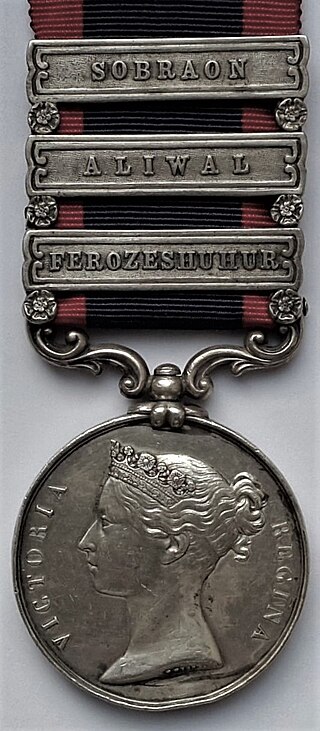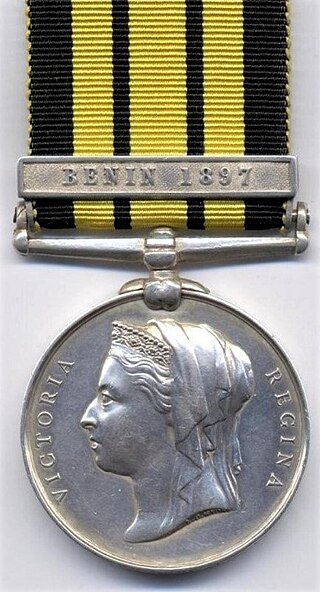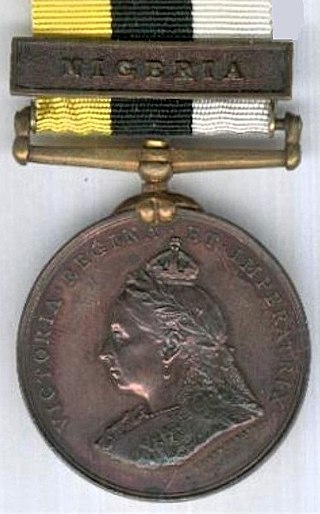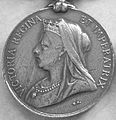Description
The medal was awarded in silver to soldiers of the British and Indian armies, and in bronze to native bearers and servants. [3]
The obverse shows the profile of Queen Victoria or, for those awarded the medal with the Waziristan 1901–02 clasp, King Edward VII, both with a suitable inscription.
The reverse, designed by G. W. de Saulles, portrays a British and an Indian soldier together carrying a standard with the inscription "India 1895", although the Edward VII version omits the date. [3]
The 1.25 inches (32 mm) wide ribbon had five equal stripes of red, green, red, green, red. [4]
The name and details of the recipient were engraved on the edge of the medal, normally in running script. [5]
Obverse variations
Victoria (1895-1901)
Edward VII, obverse for Waziristan 1901-02
[5]

The Military General Service Medal (MGSM) was a campaign medal approved in 1847 and issued to officers and men of the British Army in 1848.

The India General Service Medal was a campaign medal approved on 1 March 1854, for issue to officers and men of the British and Indian armies. It was awarded for various minor military campaigns in India and nearby countries, between 1852 and 1895.

The Indian General Service Medal was a campaign medal approved on 1 January 1909, for issue to officers and men of the British and Indian armies. From 1919, it was also awarded to officers and men of the Royal Air Force, with the Waziristan 1925 clasp awarded solely to the RAF.

The Indian General Service Medal was a campaign medal approved on 3 August 1938, for issue to officers and men of the British and Indian armies, and of the Royal Air Force.

The Baltic Medal was a campaign medal approved on 6 June 1856, for issue to officers and men of the Royal Navy, Royal Marines, and Royal Sappers and Miners who served between March 1854 and August 1855 in the Baltic Sea operations against Russia in the Baltic theatre of the Crimean War, or Åland War. The medal primarily covered naval actions but was also awarded to 106 men of the Royal Sappers and Miners who were landed to place demolition charges against Russian fortifications at Bomarsund and Sveaborg.

The Army of India Medal (AIM) was a campaign medal approved in 1851 for issue to officers and men of the British Army and the Army of the Honourable East India Company. A retrospective award following the precedent set by the Naval General Service Medal and the Military General Service Medal, it served to reward service in various actions from 1803 to 1826.

The Sutlej Medal was a campaign medal approved in 1846, for issue to officers and men of the British Army and Honourable East India Company who served in the Sutlej campaign of 1845–46. This medal was the first to use clasps to denote soldiers who fought in the major battles of the campaign.

The East and Central Africa Medal, established in February 1899, was a British campaign medal awarded for minor military operations in the Uganda Protectorate and Southern Sudan between 1897 and 1899. Four separate clasps were issued.

The East and West Africa Medal, established in 1892, was a campaign medal awarded for minor campaigns that took place in East and West Africa between 1887 and 1900. A total of twenty one clasps were issued.

The Tibet Medal was authorised in February 1905 for all members of the Tibet Mission and accompanying troops who served at or beyond Siliguri from 13 December 1903, to 23 September 1904.

The Africa General Service Medal, established in 1902, was a campaign medal of the United Kingdom. It was awarded for minor campaigns that took place in tropical Africa between 1900 and 1956, with a total of forty five clasps issued. The medal is never seen without a clasp and some are very rare. Most medals were granted to British led local forces, including the King's African Rifles and the West African Frontier Force. The only campaigns where European troops were present in any numbers were the various Somaliland campaigns,, and in Kenya.

The Ashantee Medal is a British campaign medal instituted on 1 June 1874. It was awarded to British, Colonial and allied native forces, under the command of Major General Sir Garnet Wolseley, who were deployed against the army of the Ashanti King Kofi Karikari, during the Third Anglo-Ashanti War, June 1873 to February 1874.

The Ashanti Medal was sanctioned in October 1901 and was the first campaign medal authorised by Edward VII. This medal was created for those troops engaged in the Third Ashanti Expedition, also known as the War of the Golden Stool. This expedition lasted from March – December 1900, with the final outcome that the Ashanti maintained its de facto independence. Ashanti was made a Protectorate of the British Empire, but they ruled themselves with little reference to the colonial power.

The Kabul to Kandahar Star, also known as the Roberts Star or Kandahar Bronze Star was awarded to those British and Indian troops who participated in the 320 mile march from Kabul to Kandahar in Afghanistan between 9–31 August 1880, under the command of Lieutenant-General Sir Frederick Robertswho rode horseback on his horse Vonolel In addition, it was awarded to the troops stationed en route at Kelat-i-Ghilzie, who accompanied General Roberts on the final ninety miles to Kandahar.

The Jellalabad Medal was a campaign medal issued by the British East India Company. It was established by Lord Ellenborough, the Governor-General of India, on 30 April 1842.
The medal was awarded for the defence of Jalalabad from 12 November 1841 to 7 April 1842, during the First Afghan War, to the troops under the command of Sir Robert Sale. About 2,600 soldiers took part, including the 13th Foot, the 35th Bengal Native Infantry, as well as detachments from other Indian Army units and some loyal Afghan forces.

The Khedive's Star was a campaign medal established by Khedive Tewfik Pasha to reward those who had participated in the military campaigns in Egypt and the Sudan between 1882 and 1891. This included British forces who served during the 1882 Anglo-Egyptian War and the subsequent Mahdist War, who received both the British Egypt Medal and the Khedive's Star. Cast in bronze and lacquered, it is also known as the Khedive's Bronze Star.

The Central Africa Medal was a British campaign medal awarded for service from 1891–1894 in Eastern and Central Africa, and from 1894–1898 for service in British Central Africa.

The Khedive's Sudan Medal was a campaign medal awarded by the Khedivate of Egypt to both Egyptian and British forces for service during the reconquest of the Sudan, the final part of the Mahdist War. Established 12 February 1897 by Khedive Abbas Hilmi Pasha, this medal was initially to commemorate the reconquest of the Dongola province in 1896. It was subsequently authorised for later campaigns and actions until 1908. The medal was awarded with fifteen different clasps.

The Royal Niger Company’s Medal was a campaign medal issued in 1899 by the Royal Niger Company for service in minor military operations in Nigeria between 1886 and 1897. The award was approved by the British government and could be worn by British servicemen.

The Nepal Medal was awarded by the Honourable East India Company (HEIC) to native Indian officers, and Indian soldiers for particularly distinguished conduct, during the Anglo-Nepalese War of 1814–16.
























